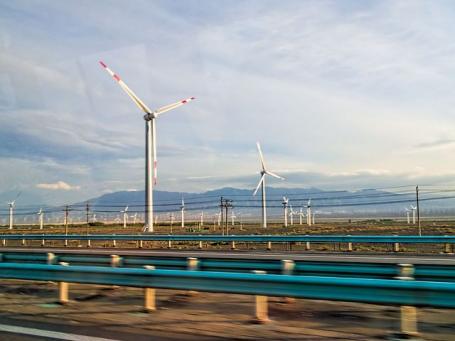6 Issues to Watch at the Clean Energy Ministerial

President Trump may havepulled the United States out of the Paris Agreementon climate change, but the rest of the world is continuing to move toward a low-carbon future.
Representatives from countries accounting for 90 percent of the world’s clean energy investment and 75 percent of its greenhouse gas emissions—including the United States—will gather in Beijing this week to discuss how to scale renewables, improve efficiency and cooperate on clean energy initiatives. Theeighth Clean Energy Ministerial(CEM8) in Beijing brings together energy ministers and high level decision-makers from 24 countries and the European Commission. Together with technical experts and private sector leaders, these officials will join in three days of closed-door roundtables, technology exhibitions, keynote addresses and more.
For the world’s only major multilateral forum on clean energy, it’s a year of transition. Several member countries have new political leadership, and the CEM secretariat has shifted from the United States, where it had been housed for the last eight years, to the multilateral International Energy Agency (IEA).
Here are six issues to watch at CEM8:
1. What new multilateral partnerships will emerge?
A core function of the CEM meetings is to demonstrate what is possible in advancing clean energy. The peer learning among top energy ministers and decision-makers influences national clean energy programs by providing examples of countries accelerating their low-carbon transition while growing the economy.
The annual meetings often see the launch of multilateralcampaigns, short-term efforts to make progress on specific areas. Three new campaigns on power plant flexibility, electric vehicles and building efficiency will launch, joining four active campaigns on cooling, corporate sourcing of renewables, energy management and lighting.
2. How will the United States engage on a clean energy agenda its leadership has rejected?
U.S. Energy Secretary Rick Perry has a record of growing wind power in his home state of Texas, but his public comments since joining the Trump administration have given less than full-throated support for renewable and efficiency technologies.
Inremarksthis April, Perry sent mixed messages on clean energy despite its declining cost and increased use around the world. While he said the U.S. Department of Energy (DOE) would “ensure” renewable energy is available on the grid, he also said the Clean Power Plan and other policies to reduce pollution from the power sector were “driven by a hostility to coal” and threatened grid reliability. Likewise, Perry said U.S. policy had favored renewables at the expense of fossil fuels.
In Beijing, watch Secretary Perry for signals on where the new administration will prioritize collaboration on energy, and whether these priorities match up with those of the rest of the world. Will peer countries want to partner with the United States on energy innovation, or will the country be left out of new partnerships as others move forward? This will be a dynamic to watch during CEM8 and the months that follow.
3. What vision will Chinese leaders bring?
China ismakingsignificant domestic and international investments in clean energy. In January, China’s energy agencyannounced$361 billion of investment in renewable power by 2020. Last year, Chinaboostedits foreign investment in renewables by 60 percent, hitting a record $32 billion. China is also making progress onpolicies for energy-efficient buildingsand increasing sales of electric vehicles.
At CEM8, look for signals that China will re-affirm its intent to be a clean energy leader, with clean energy investments part of a broader vision of economic growth in China and with major investment partners. Will we see new partnerships between China and other countries on clean energy?
4. Will ministers build on private sector demand for clean energy?
Corporate demand for clean energy is growing in CEM countries. InIndia, theUnited Statesandacross Southeast Asia, business leaders want more renewable energy options on the grid. Last year, CEM leaderslauncheda campaign to increase the number of companies using renewable energy to power their operations.
At CEM8, look for new announcements from companies and governments in support of this campaign. A day-longCorporate Sourcing of Renewablesside event will include high-level government speakers and leaders from Fortune 100 companies.
5. How will CEM8 advance energy efficiency?
Leaders of major initiatives like Sustainable Energy for All havestressedthe significance of rapidly improving energy efficiency technology to transition to clean energy systems.
Two of the fourofficial public-private roundtablesat CEM8 will cover efficiency topics. One will examine how to integrate renewable and efficiency policies at the national level. A second will discuss how national governments can work with cities and businesses to increase the efficiency of buildings, highlighting best practices from city initiatives like the WRI-ledBuilding Efficiency Acceleratorand WBCSD’sAmplifyprogram.
At CEM8, look for the launch of a new campaign focused on building efficiency, a full-day side event on the Global Lighting Challenge and the importance of efficient lighting, and a side event on making the business case for energy efficiency. These campaigns can generate important political support needed to make progress over the year.
6. How to fill the innovation and R&D funding void?
Several new clean energy technologies are poised for breakthroughs, but government funding for research and development isat riskin the United States. This threatens initiatives likeMission Innovation, a partnership of 22 countries and the EU that aims to raise $30 billion per year by 2021 for clean energy research and development.
In Beijing, expect updates on Mission Innovation’sworkon technologies like low-carbon heating and cooling in buildings, advanced biofuels and converting sunlight to storable fuels.
An even more importantdiscussionwill be how governments plan to move Mission Innovation’s agenda forward in the face of a potential U.S. funding gap. This could include how private sector leaders like the $1 billion investor-ledBreakthrough Energy Venturesfund can collaborate to advance new technologies.
Authors:
Daniel Melling, Communications Specialist, WRI
Alex Perera, Deputy Director, Energy Program, WRI
Debbie Weyl, Manager, Building Efficiency, WRI
Photo: China’s largest wind turbine facility, the Dabancheng Wind Power Station. by Dan Lundberg/Flickr